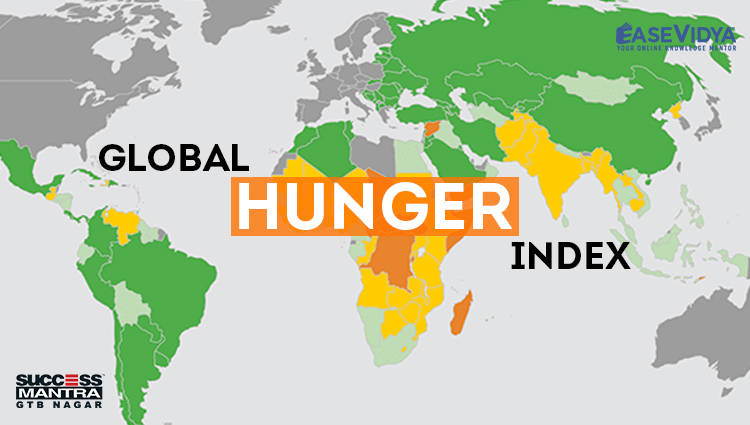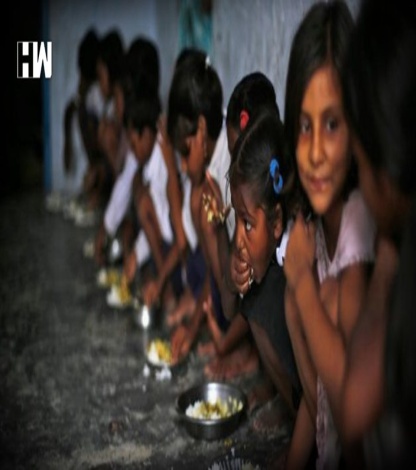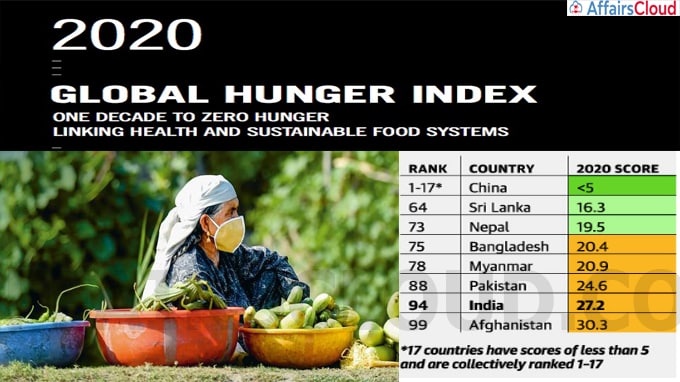
GLOBAL HUNGER INDEX
GLOBAL HUNGER INDEX (GHI)
The Global Hunger Index (GHI) is a tool that measures and tracks hunger globally as well as by region and by country. The GHI is calculated annually, and its results appear in a report issued in October each year. After declining since 2000, hunger at the global level is classified as moderate, according to the 2020 report. Many individual countries have also achieved reductions in hunger since 2000, but in some countries hunger persists or has even worsened.

Created in 2006, the GHI was initially published by the US-based International Food Policy Research Institute (IFPRI) and Germany-based Welthungerhilfe. In 2007, the Irish NGO Concern Worldwide also became a co-publisher. In 2018, IFPRI stepped aside from its involvement in the project and the GHI became a joint project of Welthungerhilfe and Concern Worldwide. The 2020 Global Hunger Index report presents a multi-dimensional measure of national, regional, and global hunger by assigning a numerical score based on several aspects of hunger. It then ranks countries by GHI score and compares current scores with past results. Besides presenting GHI scores, each year the GHI report includes an essay addressing one particular aspect of hunger. The 2020 report considers a One Health approach to linking health and sustainable food systems in order to achieve Zero Hunger by 2030.
CALCULATION OF GLOBAL HUNGER INDEX
The Global Hunger Index measures hunger on a 100-point scale, with 0 being the best score (no hunger) and 100 being the worst, although neither of these extremes is reached in practice.
The GHI combines 4 component indicators:
• The proportion of the undernourished as a percentage of the population;
• The proportion of children under the age of five suffering from wasting, a sign of acute undernutrition
• The proportion of children under the age of five suffering from stunting, a sign of chronic under nutrition
• The mortality rate of children under the age of five.
In 2020, data were assessed for the 132 countries that met the criteria for inclusion in the GHI, and GHI scores were calculated for 107 of those countries based on data from 2015 to 2019. Data to calculate GHI scores come from published United Nations sources (Food and Agricultue Organization of the United Nations, World Health Organization, UNICEF, and Inter-agency Group for Child Mortality Estimation, the World Bank, and Demographic and Health Surveys. Of the 132 countries assessed, 25 did not have sufficient data to allow for the calculation of a 2020 GHI score.
FOCUS OF GLOBAL HUNGER INDEX 2020
The Focus of the 2020 GHI is "One Decade to Zero Hunger: Linking Health and Sustainable Food Systems". The events of 2020 are laying bare many of the vulnerabilities of the world’s food system in ways that are becoming impossible to ignore. However, by taking an integrated approach to health and food and nutrition security, it may yet be possible to achieve Zero Hunger by 2030. A One Health approach, which is based on a recognition of the interconnections between humans, animals, plants, and their shared environment, as well as the role of fair trade relations, would address the various crises we face holistically and help avert future health crises, restore a healthy planet, and end hunger. A One Health lens brings into focus a number of weaknesses including the fragility of globalized food systems; underinvestment in local farmers, farmer associations, and small-holder oriented value chains etc. To ensure the right to adequate and nutritious food for all and achieve Zero Hunger by 2030, we must approach health and food and nutrition security in a way that considers human, animal, and environmental health and fair trade relations holistically.
REPORT ON GLOBAL HUNGER INDEX 2020

Global Scenario: Worldwide Hunger is represented by a GHI score of 18.2 (moderate level), down from a 2000 GHI score of 28.2 (serious). The factors that affects the worldwide hunger is the Covid-19 pandemic and the resulting economic downturn, as well as a massive outbreak of desert locusts in the Horn of Africa and other crises, are exacerbating food and nutrition insecurity for millions of people. It needs to be noted that 2020 GHI scores do not reflect the impact of Covid-19 on hunger and under nutrition.
Region-wise Performance: Africa South of the Sahara and South Asia have the highest hunger and under nutrition levels among world regions, with 2020 GHI scores of 27.8 and 26.0, respectively—both considered serious. The world is not on track to achieve the second Sustainable Development Goal - known as Zero Hunger for short - by 2030.
Indian Scenario: With a score of 27.2, India has a level of hunger that is “serious”. It ranks 94 out of 107 countries in the Index. In 2019, India’s rank was 102 out of 117 countries. India features behind Nepal (73), Pakistan (88), Bangladesh (75), and Indonesia (70) among others. Out of the total 107 countries, only 13 countries fare worse than India including countries like Rwanda (97), Nigeria (98), Afghanistan (99) & Chad (107) among others.
Performance on the Indicators:
Undernourishment: 14% of India’s population is undernourished (2017-19). It was 16.3% during 2011-13.
Child Wasting: 17.3% (2015-19), it was 15.1% in 2010-14.
Child stunting: 34.7%, it has improved significantly, from 54% in 2000 to less than 35% now.
Child Mortality: 3.7%, it was 5.2% in 2012.
INITIATIVES BY INDIA TO COMBAT HUNGER
• Eat Right India Movement: An outreach activity organized by the Food Safety and Standards Authority of India (FSSAI) for citizens to nudge them towards eating right.
• POSHAN Abhiyan: Launched by the Ministry of Women and Child Development in 2018, it targets to reduce stunting, under nutrition, anemia (among young children, women and adolescent girls).
• Pradhan Mantri Matru Vandana Yojana: A centrally sponsored scheme executed by the Ministry of Women and Child Development, is a maternity benefit programme being implemented in all districts of the country with effect from 1st January, 2017.
• National Food Security Act, 2013: The National Food Security Act, (NFSA) 2013 legally entitled up to 75% of the rural population and 50% of the urban population to receive subsidized food grains under the Targeted Public Distribution System.
• Mission Indradhanush: It targets children less than 2 years of age and pregnant women for immunization against 12 Vaccine-Preventable Diseases (VPD).
QUESTIONS (1-5)
Q.1 Global Hunger Index report 2020 is co-published by which of the following institutions?
A. US based International Food Policy Research Institute (IFPRI)
B. Germany-based Welthungerhilfe
C. Irish NGO Concern Worldwide
D. Both B & C: ANSWER
Q.2 Global Hunger Index report 2020 is calculated on the basis of four factors. Which of the following is not one of these?
A. Undernourishment
B. Child Stunting
C. Child Abuse: ANSWER
D. Child Mortality
Q.3 What is the India's rank in the Global Hunger Index 2020 in which data were assessed for the 132 countries and GHI scores were calculated for only 107 countries?
A. 76TH Rank
B. 85TH Rank
C. 91ST Rank
D. 94TH Rank: ANSWER
Q.4 Every year the Global Hunger Index is focused upon something. What is the focus of the GHI report 2020?
A. Challenge of Hunger & climate change
B. One Decade to Zero Hunger: Linking Health and Sustainable Food Systems: ANSWER
C. Forced Migration and Hunger
D. Early childhood nutrition
Q.5 From the following options, which of the following is not an initiative started by the Government of India to combat Hunger?
A. Mission Shakti: ANSWER
B. Mission Indradhanush
C. Poshan Abhiyan
D. Eat right India movement













ieyfvqhw
GLOBAL HUNGER INDEX | SUCCESS MANTRA COACHING INSTITUTE DELHI <a href="http://www.gayr63p310c8fyd005bzyl6y065369shs.org/">aieyfvqhw</a> ieyfvqhw http://www.gayr63p310c8fyd005bzyl6y065369shs.org/ [url=http://www.gayr63p310c8fyd005bzyl6y065369shs.org/]uieyfvqhw[/url]
jkrtlyridk
GLOBAL HUNGER INDEX | SUCCESS MANTRA COACHING INSTITUTE DELHI <a href="http://www.gjq1ej0a386s1yhs1p302u7hz6571i4ks.org/">ajkrtlyridk</a> [url=http://www.gjq1ej0a386s1yhs1p302u7hz6571i4ks.org/]ujkrtlyridk[/url] jkrtlyridk http://www.gjq1ej0a386s1yhs1p302u7hz6571i4ks.org/
swpnciiehd
GLOBAL HUNGER INDEX | SUCCESS MANTRA COACHING INSTITUTE DELHI swpnciiehd http://www.g1ag4f052690s0t7vki5h85cnse76ph6s.org/ [url=http://www.g1ag4f052690s0t7vki5h85cnse76ph6s.org/]uswpnciiehd[/url] <a href="http://www.g1ag4f052690s0t7vki5h85cnse76ph6s.org/">aswpnciiehd</a>
ljsjcmmmp
GLOBAL HUNGER INDEX | SUCCESS MANTRA COACHING INSTITUTE DELHI ljsjcmmmp http://www.gn6j9s6q5683331cxhd99a28k3cexws7s.org/ [url=http://www.gn6j9s6q5683331cxhd99a28k3cexws7s.org/]uljsjcmmmp[/url] <a href="http://www.gn6j9s6q5683331cxhd99a28k3cexws7s.org/">aljsjcmmmp</a>
lmiphwehwy
Latest News on Education & LAW Exams Blogs | Success Mantra <a href="http://www.gzk041s43a74wp1tojf3y3d8271mr87ks.org/">almiphwehwy</a> lmiphwehwy http://www.gzk041s43a74wp1tojf3y3d8271mr87ks.org/ [url=http://www.gzk041s43a74wp1tojf3y3d8271mr87ks.org/]ulmiphwehwy[/url]
tsiofgfzi
Latest News on Education & LAW Exams Blogs | Success Mantra [url=http://www.gxouy8dz42297igc02277qoi96w470xvs.org/]utsiofgfzi[/url] tsiofgfzi http://www.gxouy8dz42297igc02277qoi96w470xvs.org/ <a href="http://www.gxouy8dz42297igc02277qoi96w470xvs.org/">atsiofgfzi</a>
yvfzjtseo
Latest News on Education & LAW Exams Blogs | Success Mantra <a href="http://www.g0j257kbyzlq5187z583uv65nzip08e9s.org/">ayvfzjtseo</a> yvfzjtseo http://www.g0j257kbyzlq5187z583uv65nzip08e9s.org/ [url=http://www.g0j257kbyzlq5187z583uv65nzip08e9s.org/]uyvfzjtseo[/url]
vnpbfire
Latest News on Education & LAW Exams Blogs | Success Mantra vnpbfire http://www.gfa97s250absi5273rjc4v7p330ofe39s.org/ <a href="http://www.gfa97s250absi5273rjc4v7p330ofe39s.org/">avnpbfire</a> [url=http://www.gfa97s250absi5273rjc4v7p330ofe39s.org/]uvnpbfire[/url]
vtoeemxtcj
Latest News on Education & LAW Exams Blogs | Success Mantra <a href="http://www.g010p5m5wf9413993s6d4xu4jmw2ebtks.org/">avtoeemxtcj</a> vtoeemxtcj http://www.g010p5m5wf9413993s6d4xu4jmw2ebtks.org/ [url=http://www.g010p5m5wf9413993s6d4xu4jmw2ebtks.org/]uvtoeemxtcj[/url]